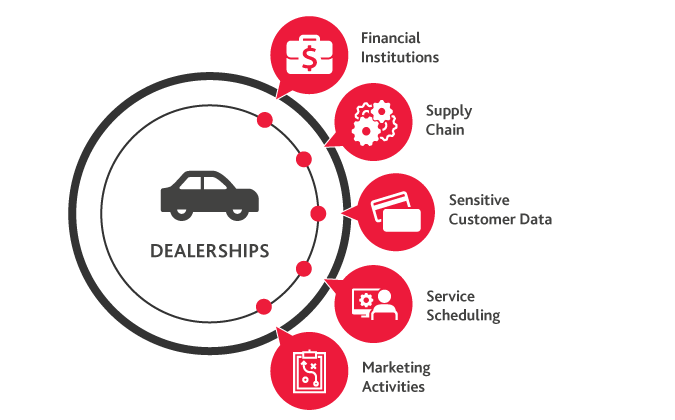Why Dealerships Must Prioritize Cybersecurity
While the day-to-day operations of a dealership might vary greatly from other types of businesses, they all still have one thing in common: the need for cybersecurity. Every business, no matter what line of work they are in, needs to secure their data and do everything they can to prevent accidental leakage or malicious attacks.
The threats to dealerships are pervasive. There are so many moving parts to keep track of (and we’re not just talking about the vehicles here). Dealerships have relationships with financial institutions, for lending purposes, and across the supply chain. They deal with a wealth of sensitive customer data such as names, social security numbers, and credit card information. Their service scheduling could be automated. They are taking part in marketing activities.

When talking about cybersecurity, so many different relationships can only mean one thing: greater risk. So, how can your dealership protect against cyber threats? Here are a few tips to get started:
1. CONTINUOUS PREPARATION IS A DEALERSHIPS BEST DEFENSE |
|
|
The biggest thing that is going to affect a dealership is a hit on their brand. No dealership wants to see themselves in the media with the news they were subject to a breach. News like that could affect consumer confidence in the dealership thereby hurting business, as well as the overall brand. |
|
2. DRAFTING AND PRACTICING AN INCIDENT RESPONSE PLAN |
|
|
Simply having an incident response plan is just the beginning. Once you develop a plan, you must put it into practice, question it, and make revisions as you see fit. If an incident occurs, ask yourself, “what lessons did we learn from this? |
|
3. DISASTER RECOVERY COMMUNICATION PROCESS |
|
|
A disaster recovery plan must also be developed, implemented, and practiced just like an incident response plan. It should clearly outline how your dealership responds and quickly resumes work following an unforeseen disaster. In the plan, document who dealership employees should communicate with and how they should communicate with each other during different phases. Additionally, make sure everyone within your dealership is educated about how the plan works. |
4. OFFERING CONTINUING EDUCATION TO ALL PROFESSIONALS |
||
|
In addition to having documented plans for incidents and disasters, it’s also important to offer continuing education to all employees. All it takes is one human error for disaster to ensue within a dealership. If your people aren’t educated, they can be the biggest threat to the organization. |
||
5. CYBER INCIDENT EXERCISES FOR ALL EMPLOYEES |
||
|
Beyond continuing education, employees must also be prepared for any scenario that may present itself. What is the best way to make sure they’re prepared? With realistic exercises. Practice makes perfect, and the more practice your employees have, the less vulnerable you’ll be to cyber threats. |
||
6. CREATING A CULTURE OF AWARENESS AND REPORTING |
||
|
Creating a culture within the dealership that not only makes employees aware of cybersecurity but also encourages them to report incidents will only help you. Cybersecurity shouldn’t just be a top priority among executives, make sure it’s a part of the culture within your organization. |
||
7. ROBUST AND TIMELY THREAT DATA |
||
|
Knowing how to respond to threats is important, but you must also effectively manage risk. This means having access to robust and timely threat data. Does your dealership |
||
8. ADEQUATE INSURANCE COVERAGE |
||
|
No matter how confident you are in your security posture, your mindset should never be, “what will we do if a cyber incident occurs?” But rather, you should ask yourself, “what will we do when a cyber incident occurs?” Any business can fall victim to cyber threats, and because of that, it’s smart to have insurance. This can offset any financial losses that may happen because of a cyber-attack. |
||
Most dealerships don’t have people on staff that understand the current realities of what cyber is today. With an ever-evolving threat landscape, it is imperative that investments in cybersecurity are smart and pragmatic to protect your dealership.
The cyber specialists within BDO Digital can lend their experience and help you improve your dealership. BDO Digital’s security maturity quiz can give you an idea of how secure you are currently. Additionally, we recommend engaging in a deeper conversation around your threat landscape as it relates to cyber to find the comprehensive solution that is right for you. Contact us today to get started.
SHARE